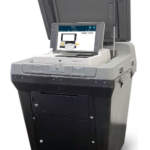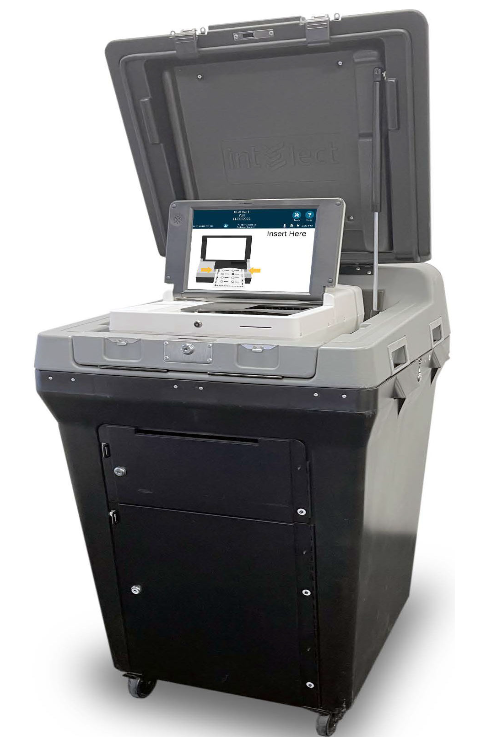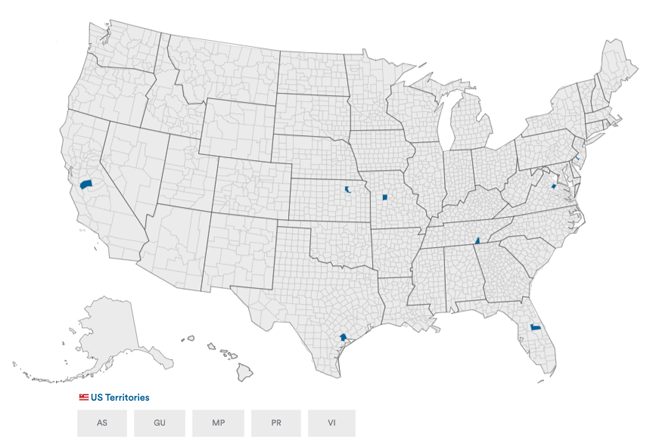
Election Systems & Software
DS300
Make / Model: ES&S DS300
Equipment Type: Hand-Fed Optical Scan Tabulator
Overview

The ES&S DS300 is a ballot scanning device. It is used in jurisdictions in which voters hand mark paper ballots and/or use ballot marking devices then hand-feed their paper ballots into a scanner. Ballots can be inserted into the DS300 in multiple orientations: face up, face down, header first, or footer first. The device simultaneously scans the front and back of a paper ballot, interprets voter marks, and communicates any issues that require the voter’s attention back to the voter through an LCD display. If the voter has marked too many choices in a race, the display alerts the voter and offers the option to return the ballot for correction.
The DS300 scanner can also scan and tabulate the summary cards (or “ballot cards”) printed by ES&S ExpressVote ballot marking devices (BMDs). ExpressVote-produced ballots print a paper “summary card” of the voter’s choices with a barcode that encodes the voter choices. When the paper record is hand-fed into the DS300 scanner, it scans the barcode to interpret voter choices and record votes.
Because the DS300 device is a scanning device only, and does not have features that support marking choices on ballots, features that may be helpful to voters with disabilities are limited; the DS300 is not marketed as an “accessible voting device.” It does not have an audio-tactile controller and its audio features are limited to only making different sounds as ballots are scanned or returned to the voter when marks require additional attention.
After the voter inserts their paper ballot (or summary card) into the DS300 scanner, they have a chance to review any potential mismarks that require attention. After the voter cast their ballot, the DS300 scanner pulls the ballot through a motorized feed and deposits the ballot into an integrated ballot box. The DS300 device has tabulating capabilities, and when the polls close, the DS300 can print out the race results and other information on a paper tape (if configured to do so). A DS300 configured for an early voting location does not support precinct level results reporting; however, an election summary report of tabulated vote totals is supported.
The DS300 storage limitation for write-in ballot images is 3,600 images. To successfully use the write-in report, ballots must span three or more vertical columns. If the column is greater than 1/3 of the ballot width, the write-in image will be too wide to print on the report tape. The DS300 uses a TDS ink cartridge for ballot stamping.
Voting Process

When the voter has finished filling out their ballot, they should check it to ensure their selections match their intentions. Next, the voter feeds their ballot into the DS300 machine. After the ballot is scanned and accepted, the voter’s ballot cannot be redone. If the scanner is malfunctioning, voters should follow poll worker instructions, which may include inserting the ballots directly into the ballot box underneath the DS300 scanner.
As votes are entered, the DS300 stores the vote tallies on its internal memory card. Optional land line and wireless modems are available. When the polls close, the DS300’s internal printer prints out the precinct’s vote report on paper.
The DS300 is coded to detect and notify the voter when it encounters an overvoted race or issue on the ballot. An overvote is when more than the allowed number of selections in a race or issue has been marked. An audio alert will sound and the display will indicate that an over-voted race or issue was detected and offer the voter two choices: “Accept” or “Return.”
If the voter selects Accept, the ballot will be counted, all properly marked races and issues will receive the appropriate votes, and the over-voted races and issues will receive an over-vote. The individual candidates or issue choices in an over-voted race will not receive any votes.
If the voter selects Return, the ballot will be returned uncounted, and the voter may contact the election official and have the ballot spoiled and receive a new one.
Overvoting should not be confused with undervoting. A voter undervotes when they cast fewer votes for a particular office than they are permitted to cast. No ballot or vote will be canceled as a result of an undervote.
Resources
Manufacturer Profile
Election Systems & Software was founded in 1979 as American Information Systems Inc. (AIS), it merged with Business Records Corp. the following year and changed its name to ES&S. It is now a subsidiary of McCarthy Group, LLC, and McCarthy Capital. As of 2007 it was the largest manufacturer of voting machines in the United States, claiming customers in 1,700 localities. As of 2007 it had approximately 350 employees; 2005 revenues were $117 million. ES&S announced its purchase of AutoMARK Technical Systems on January 28, 2008.
